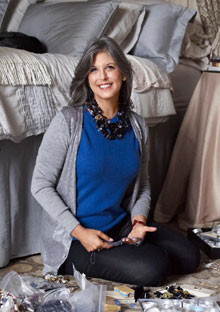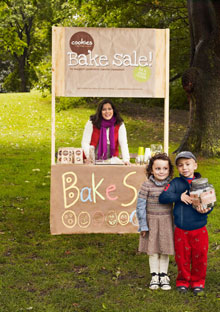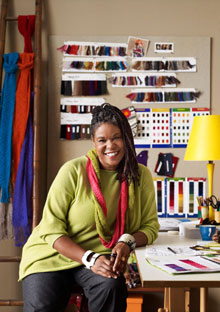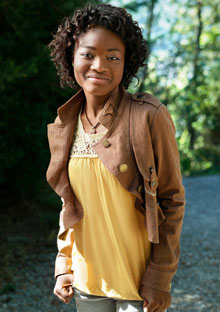
Photo: Roland Bello
Joan Hornig's jewelry comes from the heart. And 100 percent of the profits go to a charity of your choice.
When she was in college, Joan Hornig set a big goal: to earn enough money by age 50 to allow her to give
back to the world. In 2003 she met that goal, two years ahead of schedule.Because Hornig, 54, came from a modest background, she learned to design her own jewelry, modeling her pieces after the bold, fanciful antiques she admired in luxury boutiques and museums. Six years ago, when a friend casually said, "I love your necklace," Hornig replied, "Thanks, I made it." That prompted the friend to call another friend—who just happened to be a merchandise manager at Bergdorf Goodman—and say: "I'm looking at something that should be in your store."
Hornig went back to her New York City apartment, gathered up all the necklaces, bracelets, and earrings she'd made (stored in Tupperware containers in her china cabinet—"I didn't even know there was such a thing as a jewelry roll"), and took them into the Fifth Avenue store. "The Bergdorf people said, 'We like these things, but are you a business?' I said, 'I believe I can be a business.'" They offered her a trial run, and her first "collection" sold out in five days. The secret to her success? "I think jewelry should do for women what a beauty parlor does," Hornig says. "Enhance them."
But Hornig, who worked in the lucrative field of private equity investing, didn't start designing jewelry to make a profit, so she devised a novel business model: Each piece she sells comes with a card explaining that she will give 100 percent of her profits to the charity of the buyer's choice. "To my children, Paul Newman wasn't an actor—he was a philanthropist who made salad dressing," she says. "But he chose the charities that would profit from Newman's Own. I wanted to go one step further and let people choose their own cause."
Through sales of her jewelry, the Joan B. Hornig Foundation has donated close to $750,000 to more than 600 causes, including hospitals, dance companies, schools, and the environment. "People ask, 'Why wouldn't you want to keep the money?'" she says. "They think success is measured by what you put in your pocket. I get to create beautiful things that make a difference for people. There isn't anyone who's been made richer by this experience than me." — Aimee Lee Ball
Next: A cookie business that's raising funds for cancer

Photo: Roland Bello
After her son's diagnosis, Gretchen Holt Witt had a sweet idea: a cookie business that raises funds for pediatric cancer.
For Gretchen Holt Witt, life is divided neatly into before and after February 2007. That's when her 2-year-old
son, Liam, was diagnosed with stage IV neuroblastoma, a cancer of the nervous system. "It's like a bomb
went off in my life," she says. "As a parent, the last thing you want to hear is that your child has the C word." After Liam underwent 11 hours of surgery and five rounds of chemotherapy, Witt learned about another treatment in the research pipeline that could help him. Unfortunately, there was no funding for its development. In fact, her oncologist told her that even though cancer kills more children than any other disease, it receives just 4 percent of the National Cancer Institute's roughly $5 billion annual research budget. "I asked him, 'Why don't I know this?'" says Witt. "His answer was: 'Because kids with cancer don't make headlines.'"
That December she recruited 250 volunteers and held a giant bake sale (nearly 100,000 cookies, made with 167 dozen eggs, 667 pounds of butter, and 833 pounds of flour). "I'd always worked for companies that deal with food prep," says Witt, 42, now head of corporate communications for OXO kitchen tools, "and I thought, Do something you know." The sale raised more than $400,000—plus a lot of interest from parents who wanted to help in their own communities. Witt realized: 'We're onto something.'
She launched Cookies for Kids' Cancer the following September, with a website that provides all you need to stage a charitable bake sale, including recipes, banners, and links to packaging suppliers. The site offers cookies for sale, too—chocolate chip, oatmeal raisin, and lemon sugar, all made with natural ingredients—and at least 70 percent of the purchase price goes to fund pediatric cancer research at comprehensive cancer centers like Dana-Farber in Boston, Texas Children's Hospital in Houston, and Memorial Sloan-Kettering Cancer Center in New York, where Liam was treated.
The group has inspired more than 200 bake sales, raising hundreds of thousands of dollars. "There's never been a week that I go to the mailbox and don't find the proceeds from a bake sale," says Witt, who works with her husband, Larry, a medical advisory board, and a board of directors to review applications for the funds. Even though Liam is doing well, there's no cure for his cancer, and his mom knows that money and awareness are the only defense against the disease. As such, to Witt, the C word now means cookies. "A bake sale is just one way to do the right thing," she says. "But do something." — Aimee Lee Ball
Next: Giving hope to craftspeople all over the world

Photo: Roland Bello
By selling their handwoven textiles, Patti Carpenter gives hope to the craftspeople who create them.
To celebrate the millennium, Patti Carpenter headed to Brazil, where she threw flowers into the ocean
and made a simple wish: "I have a talent, and I would like to make it work in a different way." As a designer
and fashion executive, Carpenter traveled the world in style but felt unsatisfied. "The '80s and '90s were a
creative time on Seventh Avenue, but that changed," she says. "Instead of meetings about an idea or an
inspiration, the driving force was the bottom line."Returning home to New York City, Carpenter, now 54, volunteered with Aid to Artisans, a nonprofit group that promotes craft businesses in developing countries. "Twelve of us looked at products from these countries to see if the local people could make something better or different using the same skills." Within a year, she had made the first of many trips to Africa and Central and South America, where she was so impressed with the handwoven and embroidered textiles that she quit her job to start Carpenter + Company.
Now she imports beautiful throws, scarves, and table runners made by people in Guatemala and Bolivia, selling them through stores like Dean & Deluca and Bloomingdale's. Many of the craftspeople use centuries-old techniques, taking undyed wool from alpacas and weaving it on hand-built foot looms. Carpenter's efforts have helped the people she employs in unexpected ways. "I found out that some of the husbands of the women in Bolivia make costumes for Carnaval," she says, "so I put them to work embroidering pillows. They often have to leave the family to look for work, but because the crafts subsidize their existence, the families can stay together. And now that they can afford to upgrade their pumps, we've seen cleaner water come into their communities."
Today Carpenter travels the Third World, staying in hotels that may not even have hot water—but she likes it that way. "When I was feeling unfulfilled, a friend gave me a card that said: 'Be the change you want to see in the world.' The pay isn't as good, but I get so much more." — Aimee Lee Ball
Next: Transforming used munitions into objects of beauty

Photo: Farah Nosh
Liberian refugee Lovetta Conto transforms used munitions into objects of beauty.
Even as a small child, Lovetta Conto knew she wanted to be a fashion designer. But when she told people,
they'd laugh. "They said, 'You live in a refugee camp, and you think that's going to happen?'" she
says. "But I always pictured myself in a higher place, growing up like a beautiful flower out of a mud pit."Lovetta, now 17, spent a decade in the Buduburam refugee camp in Ghana, home to 47,000 people, mostly Liberians fleeing their country's civil war and its aftermath. "I often went hungry, and there was no clean drinking water," she says. "Girls were selling themselves to survive, and there was a lot of rape." But three years ago, Lovetta's talents had a chance to bloom: She was granted a Strongheart Fellowship, under a Liberian program designed to help gifted young people who have been orphaned or uprooted by war create businesses to benefit their communities. Today she designs Akawelle (the name is a combination of aka, for "also known as," and wel'le, the word for "love" in Kpelle, Lovetta's tribal language), a line of delicate jewelry made from the spent bullets of her country's war. Half of all profits from the sale of the jewelry goes to the Strongheart House, a home in Robertsport, Liberia, for displaced children and other Strongheart fellows.
Lovetta herself was displaced when she was only 8 months old: After rebels attacked, she and her father, Larry, fled their town in central Liberia (her mother was out at the time, and Larry assumed she had been killed). "We walked for one week," he says. "We crossed rebel territory, slept in the bush. If I saw a breastfeeding mother, I would appeal to her to please give Lovetta milk."
After years of moving to escape the fighting, they settled at Buduburam. Lovetta lived with other families while her father looked for work. Cori Stern, founder of the Strongheart Fellowship, met Lovetta when she was just 12 and remembers how self-assured she was, even then. When officials said there was no need to build a school for disabled students because there were none in the camp, "Lovetta said, 'No—my best friend is blind, and they won't let him go to school because he can't see,'" Stern recalls. "The men did not like having a little girl go against what they were saying."
Stern brought Lovetta to the United States in 2006 to attend school. In Buduburam, Lovetta's schooling had been sporadic, and she did not learn to read until 2007 (despite the late start, she finished the entire Twilight series in six weeks). Still, the visit to the United States was bittersweet. Lovetta was shocked to see homeless people in a country of such abundance and thought it unfair that some should have so much while others had so little. She also couldn't understand why Americans did not do more to help her country's refugees: "It made me angry that this whole world was here when I was in my darkest moment, and no one came to help."
By turning bullets into things of beauty, Lovetta is doing her part to help. Since 2007 Akawelle has sold more than 400 necklaces and raised almost $20,000. Lovetta has also spoken at schools across the United States, and her necklaces have attracted fans like Halle Berry and Angelina Jolie. "I wear one, and my kids have her necklaces, too," says Jolie. "It was an opportunity to teach them about remarkable people like Lovetta, and pass on her message of love and tolerance."
Lovetta also wants her message to be one of hope: "I believe that whatever you go through, there is always new life, a new beginning. So even a bullet that has killed someone can be the same one to help a new generation." — Lisa Armstrong
Adorable presents with proceeds that go to charity: 10 more gifts that give back
More Stories of Giving
Aimee Lee Ball has cowritten four books, including No Time to Die (Harper Collins), a memoir with former Harper's Bazaar editor in chief Liz Tilberis.







